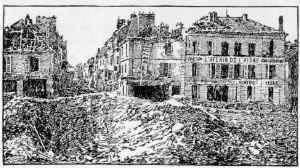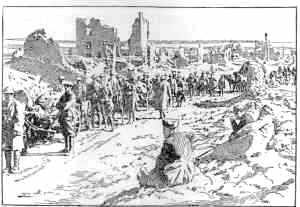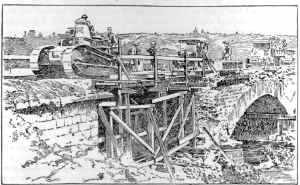Resource Center OLLibrary
|
424 |
|
[1918 |
the Americans were arriving in such large numbers that he need
wait no longer. There were then more than a million in France.
They showed in every look and action that they were eager to
grapple with the enemy and finish the work they had crossed the
sea to undertake.
General Pershing informs us that the French
Commander-in-Chief gave our soldiers "the place of honor" in the
attack. That, of course, meant that they were to stand in the
forefront of the battle. He put them there because he trusted
them.

CHIÂEAU-THIERRY, AFTER THE GERMAN RETREAT
The Germans intended to wreck the town, but
as they had to leave hurriedly they only partially succeeded. In
northern France they destroyed many villages and cities and tried
in every way to render them uninhabitable for years to come.
When all was ready Foch spoke the word and our
American troops, along with certain chosen French divisions,
hurled themselves against the Kaiser's armies. From that day
onward the great drive of the allied French, British, and American
forces would never cease until one side or the other acknowledged
itself beaten.
Weeks of desperate fighting ensued. The Germans
were pushed back slowly but constantly. They retreated step by
step until at last they found themselves driven clear back to the
line from which they had started. But they were not permitted
to
|
1918] |
|
425 |
stop even there, for they had to go back to a line behind
it.1 Their losses during their retreat were enormous.
The pursuing army captured fifteen hundred of their cannon, and
compelled them to abandon or blow up immense quantities of
ammunition. Harder still, the Germans were forced to give up a
thousand miles of the territory they had conquered. These losses
would not ruin them, but would certainly cripple them. Every one
of the five drives which the German general 2 had
directed against the Allies had

From a photograph, U.S. Official
OUR MEN ADVANCING ON ST. MIHIEL
utterly failed. At last he lost heart and sent his resignation
to the Kaiser. Some of those who knew of his withdrawal from the
war asked: iIs the time coming when the Kaiser himself will
resign? By and by we shall reach a period when this question will
be answered.
Meanwhile, Marshal Foch, for he had now received
this title, was urging on the combat, not simply in one direction
but in all. He was by nature a man who believed in offensive
rather than
1 They stopped on the
further side of the River Aisne (ane). (See Map, p. 419.)
2 General Ludendorff (see p. 419,
note).
|
426 |
|
[1918 |
in defensive movements. He said: "Nobody can alter my opinion
that to make war means to attack."
General Pershing held the same opinion. He
proceeded to put it in practice by organizing an "all-American
army," which was going to fight in a new way and in a new field.
For we must remember that up to this time our men had always acted
in connection with the French or British armies who were engaged
at different points. Now General Pershing would assume the direct
command of all Americans, though he would still permit some
divisions to remain with the French or British and to go on as
they had been doing. This arrangement had the hearty approval of
Marshal Foch.
In order to fit out the "all-American army" we
should need certain high-class cannon, besides bombing planes for
combats in the air, and tanks to root out nests of machine guns
and to break through barricades of barbed wire. Our government
could not then furnish these, and we had to buy them from the
French. We should also need plenty of gas shells1 --
the most dreadful weapon used in war. Having obtained these
implements of destruction, though we could get but few tanks, we
prepared to move forward in our work.
By referring to the map of France on page 419
and to the colored map facing page 428, you will find the town of
St. Mihiel2 on the east. It is on the River
Meuse,3 and is only a short distance from the boundary
of Germany. The enemy had captured the town and still occupied it.
Their wedge-shaped battle line which held the place was turned
toward the west. The German troops in St. Mihiel said this line
was a dagger, pointing across France to Paris, and it showed that
they would get there yet.
The men of the new American army resolved never
to rest. until they had wrenched that "dagger" out of their
hands.
1 Gas Shells. When
these shells burst they filled the air with poisonous fumes which
caused intense suffering, which might end in death. The German
military authorities introduced the use of these gases in the
spring of 1915. That, of course, compelled all other combatants to
use them. It also made it necessary for soldiers to carry gas
masks for their protection.
2 St. Mihiel (san me-yel').
3 Meuse (muze).
|
1918 ] |
|
427 |
General Pershing planned the advance as a complete surprise. He
assembled most of the men at night. They were to attack one side
of the wedge, while a number of French troops joined our men in
attacking the other side. Both forces started before sunrise on a
foggy morning in September. When they reached their destination
they announced their arrival to the astonished enemy by a
tremendous artillery fire. The moment that stopped, Pershing's men
rushed forward and, breaking through all defenses, seized the
whole wedge, including St. Mihiel, with many other

From a photograph, U.S. Official
OUR MEN WITH TANK ADVANCING ACROSS A RIVER IN THE ARGONNE
towns, and held them. By this unexpected assault we turned the
"dagger" eastward and made it point straight at the German city of
Metz,1 less than thirty miles away.
On the day after we had taken St. Mihiel our
all-American army moved northward along the banks of the Meuse on
a still greater expedition. The object of it was to drive the
Germans out of the Argonne2 -- a region of France
nearly as large as the state of Rhode Island and lying west of the
Meuse. Near the river rocky hills rise up, some a thousand feet
high. They are intersected with deep, narrow ravines difficult to
cross.
1 Metz (mets) (see Map, p. 419).
2 Argonne (ar-gon').



